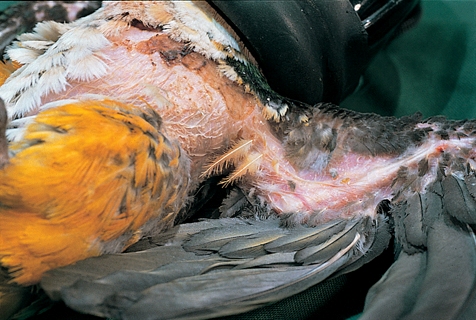Difference between revisions of "Avian Medicine Q&A 20"
Jump to navigation
Jump to search
(Created page with "<br style="clear:both;" /> {| align="left" width="100%" style="background-color:#04B4AE" |- | align="center" | 90px|Mansonlogo | align="left" | This ques...") |
|||
| (2 intermediate revisions by the same user not shown) | |||
| Line 3: | Line 3: | ||
|- | |- | ||
| align="center" | [[File:Manson_logo.gif|90px|Mansonlogo]] | | align="center" | [[File:Manson_logo.gif|90px|Mansonlogo]] | ||
| − | | align="left" | This question was provided by [[:Category:Manson|Manson Publishing]] as part of the [[OVAL Project]]. See more [[Category: Avian Medicine Q&A|Avian Medicine questions]] | + | | align="left" | This question was provided by [[:Category:Manson|Manson Publishing]] as part of the [[OVAL Project]]. See more [[:Category: Avian Medicine Q&A|Avian Medicine questions]] |
|} | |} | ||
<br><br><br> | <br><br><br> | ||
| Line 13: | Line 13: | ||
|q1= List those medical causes of feather plucking which are or may be infectious, contagious or transmissible. | |q1= List those medical causes of feather plucking which are or may be infectious, contagious or transmissible. | ||
|a1= PBFD (circovirus); budgerigar fledgeling disease (Polyomavirus: French moult); ectoparasites (e.g. ''Dermanyssus gallinae''); endoparasites (e.g. Giardia sp.); chlamydiosis; fungal dermatitis. | |a1= PBFD (circovirus); budgerigar fledgeling disease (Polyomavirus: French moult); ectoparasites (e.g. ''Dermanyssus gallinae''); endoparasites (e.g. Giardia sp.); chlamydiosis; fungal dermatitis. | ||
| − | |l1= | + | |l1=Feather Plucking#Infectious, Contagious or Transmissible Causes |
|q2= List the non-infectious medical, including metabolic, causes of feather plucking. | |q2= List the non-infectious medical, including metabolic, causes of feather plucking. | ||
|a2= Bacterial dermatitis; pulpitis or folliculitis; allergy; hepatitis; hypothyroidism; skin neoplasia; follicular cysts; post-traumatic injury, or arthritic or scar tissue pain; nutritional deficiency (e.g. hypovitaminosis A; B vitamin deficiencies; essential amino acid deficiencies (e.g. lysine)). | |a2= Bacterial dermatitis; pulpitis or folliculitis; allergy; hepatitis; hypothyroidism; skin neoplasia; follicular cysts; post-traumatic injury, or arthritic or scar tissue pain; nutritional deficiency (e.g. hypovitaminosis A; B vitamin deficiencies; essential amino acid deficiencies (e.g. lysine)). | ||
| − | |l2= | + | |l2=Feather Plucking#Non-Infectious and Metabolic Causes |
|q3= Describe the diagnosis of the aetiologies described in q1. | |q3= Describe the diagnosis of the aetiologies described in q1. | ||
|a3= PCR for PBFD and BFD; physical examination at day and night for ectoparasites; faecal examination for endoparasites; PCR/ELISA (antigen/antibody) for chlamydiosis; skin scrape microscopic examination and culture for fungal dermatitis; stained impression smear, culture and sensitivity for bacterial infections. Also, haematology | |a3= PCR for PBFD and BFD; physical examination at day and night for ectoparasites; faecal examination for endoparasites; PCR/ELISA (antigen/antibody) for chlamydiosis; skin scrape microscopic examination and culture for fungal dermatitis; stained impression smear, culture and sensitivity for bacterial infections. Also, haematology | ||
and biochemistry, thyroid stimulation test, biopsy and histopathology, improved diet and monitoring response to therapy. | and biochemistry, thyroid stimulation test, biopsy and histopathology, improved diet and monitoring response to therapy. | ||
| − | |l3= | + | |l3=Feather Plucking#Diagnosis |
|q4= List the environmental causes of feather plucking. | |q4= List the environmental causes of feather plucking. | ||
|a4= Excess tobacco smoke; excessively dry atmosphere; excessive day length in direct sunlight; lack of environmental enrichment. | |a4= Excess tobacco smoke; excessively dry atmosphere; excessive day length in direct sunlight; lack of environmental enrichment. | ||
| − | |l4= | + | |l4=Feather Plucking#Environmental Causes |
|q5= List the psychological causes of feather plucking. | |q5= List the psychological causes of feather plucking. | ||
|a5= Attention seeking; boredom; overcrowding; environmental change or lack of routine; sexual frustration; excessive preening; post untidy feather or wing clipping. | |a5= Attention seeking; boredom; overcrowding; environmental change or lack of routine; sexual frustration; excessive preening; post untidy feather or wing clipping. | ||
| − | |l5= | + | |l5=Feather Plucking#Psychological Causes |
</FlashCard> | </FlashCard> | ||
| Line 32: | Line 32: | ||
rect 0 0 860 850 [[Avian Medicine Q&A 21|Next question]] | rect 0 0 860 850 [[Avian Medicine Q&A 21|Next question]] | ||
desc none}} | desc none}} | ||
| − | [[Category: Avian Medicine Q&A | + | [[Category: Avian Medicine Q&A]] |
Latest revision as of 23:17, 21 August 2011
| This question was provided by Manson Publishing as part of the OVAL Project. See more Avian Medicine questions |
This bird has been feather plucking.
| Question | Answer | Article | |
| List those medical causes of feather plucking which are or may be infectious, contagious or transmissible. | PBFD (circovirus); budgerigar fledgeling disease (Polyomavirus: French moult); ectoparasites (e.g. Dermanyssus gallinae); endoparasites (e.g. Giardia sp.); chlamydiosis; fungal dermatitis.
|
Link to Article | |
| List the non-infectious medical, including metabolic, causes of feather plucking. | Bacterial dermatitis; pulpitis or folliculitis; allergy; hepatitis; hypothyroidism; skin neoplasia; follicular cysts; post-traumatic injury, or arthritic or scar tissue pain; nutritional deficiency (e.g. hypovitaminosis A; B vitamin deficiencies; essential amino acid deficiencies (e.g. lysine)).
|
Link to Article | |
| Describe the diagnosis of the aetiologies described in q1. | PCR for PBFD and BFD; physical examination at day and night for ectoparasites; faecal examination for endoparasites; PCR/ELISA (antigen/antibody) for chlamydiosis; skin scrape microscopic examination and culture for fungal dermatitis; stained impression smear, culture and sensitivity for bacterial infections. Also, haematology
and biochemistry, thyroid stimulation test, biopsy and histopathology, improved diet and monitoring response to therapy. |
Link to Article | |
| List the environmental causes of feather plucking. | Excess tobacco smoke; excessively dry atmosphere; excessive day length in direct sunlight; lack of environmental enrichment.
|
Link to Article | |
| List the psychological causes of feather plucking. | Attention seeking; boredom; overcrowding; environmental change or lack of routine; sexual frustration; excessive preening; post untidy feather or wing clipping.
|
Link to Article | |
